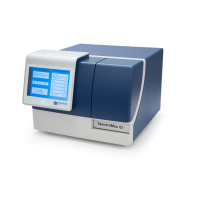Chapter 5: Read Modes and Read Types
5054747 B 93
Eliminate the Pathlength Independent Component
Raw OD measurements of microplate samples include both pathlength-dependent
components (sample and solvent) and a pathlength-independent component (OD of
microplate material). The pathlength-independent component must be eliminated from the
calculation to get valid results that have been normalized by the PathCheck technology. You
can do this using a plate blank or using a plate background constant.
Plate Blank
This method can be used if all samples in the microplate are the same volume and you do
not depend on the PathCheck technology to correct for variability in volumes.
1. Designate a minimum of one well (preferably several) as Plate Blank.
2. Pipette buffer (for example, your sample matrix) into those wells and read along with
your samples. Do not use an empty well for a blank.
The instrument automatically subtracts the average of the blank wells from each of the
samples. The OD of the microplate material is subtracted as part of the blank.
3. In SoftMax Pro, make sure the Use Plate Blank check box is selected under Other
Options on the Data Reduction dialog.
Plate Background Constant
If your sample volumes are not identical or if you choose not to use a Plate Blank, then you
must use a Plate Background Constant. The omission of a Plate Background Constant results
in artificially high values after being normalized by the PathCheck technology.
1. Fill a clean microplate with water.
2. Read at the wavelengths that you which you plan to read your samples.
The average OD value is the Plate Background Constant. If you intend to read your samples
at more than one wavelength, there should be a corresponding number of Plate Background
Constant values for each wavelength.
Note: It is important that you put water in the wells and not read a dry microplate for
the Plate Background Constant. A dry microplate has a slightly higher OD value than a
water-filled microplate because of differences in refractive indices. Use of a dry
microplate results in PathCheck technology normalized values that are lower than
1cm cuvette values.
Interfering Substances
Material that absorbs in the 900nm to 1000nm spectral region could interfere with
PathCheck technology measurements. Fortunately, there are few materials that do interfere
at the concentrations generally used.
Turbidity is the most common interference. If you can detect turbidity in your sample, you
should not use the PathCheck technology. Turbidity elevates the 900nm measurement
more than the 1000nm measurement and causes an erroneously low estimate of
pathlength. Using Cuvette Reference does not reliably correct for turbidity.

